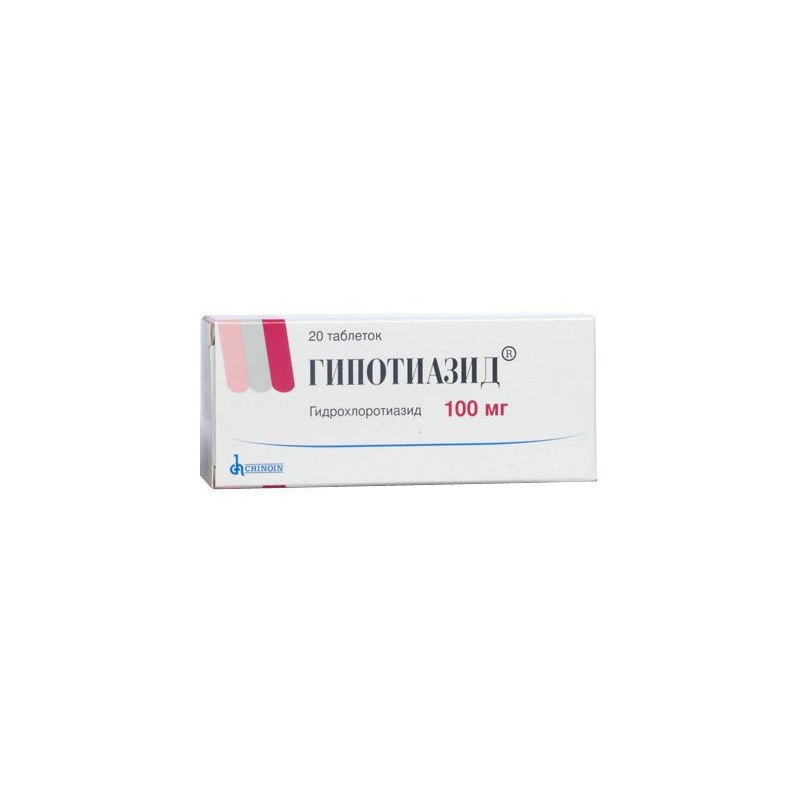



 All payments are encrypted via SSL
All payments are encrypted via SSL
 Full Refund if you haven't received your order
Full Refund if you haven't received your order
Hypothiazide pills:
1 pill contains hydrochlorothiazide 25 IL 100 mg;
Excipients: Magnesium stearate, gelatin, talc, starch, lactose;
20 pills per pack.
Hypothiazide - diuretic. Violates the reabsorption of sodium, chlorine, potassium, magnesium, and water in the distal nephron. The diuretic effect occurs after 2 hours, reaches a maximum after 4 hours and lasts 6-12 hours. It has antihypertensive properties, it is possible to use the drug for hypertension, both as monotherapy and to enhance the antihypertensive effect of other drugs. The hypotensive effect develops due to the expansion of arterioles. Thiazides do not affect normal blood pressure.
The antihypertensive effect occurs after 3-4 days, but it may take 3-4 weeks to achieve the optimal therapeutic effect. Hypotensive effect persists for a week after discontinuation of the drug.
Thiazide diuretics reduce the excretion of Calcium in the urine and thereby reduce the formation of kidney stones.
Arterial hypertension (as monotherapy and as an aid as part of a complex antihypertensive therapy);
Edematous syndrome of various genesis (includingin chronic heart failure, nephrotic syndrome, in renal failure, fluid retention in obesity);
Diabetes insipidus;
Prevention of stone formation in the urinary tract in susceptible patients.
Install individually.
Adults with edematous syndrome Hypothiazide administered at a dose of 25-75 mg / day. The maximum daily dose is 100 mg. Perhaps the daily use of the drug, but more often it is prescribed in 1-2 days.
To prevent the formation of stones prescribed 50 mg 2 times / day.
In case of arterial hypertension, the recommended dose varies from 25 to 100 mg / day, the frequency of intake is 1-2 times / day as monotherapy or as part of a combination antihypertensive therapy. In some cases, the effective use of the drug in the initial dose of 12.5 mg, if necessary, may increase the dose. The drug should be used in the minimum effective dose. The maximum daily dose is 100 mg.
When nephrogenic diabetes mellitus, the recommended initial dose of the drug is 50-100 mg / day, divided into 2-4 doses, in the future it can be reduced.
When prescribing the drug to elderly people, it should be borne in mind that patients in this age group may be more sensitive to the diuretic used in the average recommended dose.
The average daily dose for children is determined at the rate of 1-2 mg / kg body weight or 30-60 mg / m2 of body surface; a frequency rate of reception is 1-2 times / days. Children under the age of 2 years, the drug is prescribed at a dose of 12.5-25 mg / day, children aged 2 to 12 years - 25-100 mg / day.
From the side of water-electrolyte and acid-base balance: possible development of hypokalemia and hypochloremic alkalosis (dry mouth, increased thirst, heart rhythm disturbances, changes in mood and psyche, cramps or muscle pain, nausea, vomiting, unusual tiredness and weakness; with hypochloraemic alkalosis, hepatic encephalopathy or hepatic coma may develop), hyponatremia (confusion, convulsions, apathy, slowing the process of thinking, fatigue, irritability), hypomagnemia (arrhythmias).
Hemic and lymphatic: agranulocytosis, thrombocytopenia, hemolytic and aplastic anemia, leukocytopenia.
Cardiovascular: arrhythmia, orthostatic hypotension, tachycardia.
Gastrointestinal: cholecystitis, pancreatitis, jaundice, diarrhea, sialadenitis, constipation, anorexia, epigastric pain.
Metabolism: hyperglycemia, glycosuria, hyperuricemia, exacerbation of gout.
Allergic reactions: skin rash, purpura, necrotic vasculitis, Stevens-Johnson syndrome, respiratory distress (pneumonitis, non-cardiogenic pulmonary edema) photosensitivity, Anaphylactic reactions (up to life-threatening anaphylactic shock).
Other: decrease in potency.
Anuria; severe forms of gout; severe diabetes mellitus; pregnancy; lactation (breastfeeding); hypersensitivity to the drug and other sulfonamide derivatives.
Be wary appoint Hypothiazide with pronounced renal dysfunction. In this category of patients may develop a cumulative effect of the drug and the occurrence of azotemia. If the progression of kidney disease is not in doubt, diuretic therapy should be suspended or discontinued. When QA is less than 30 ml / min, thiazide diuretics lose their therapeutic efficacy, in these cases loop diuretics are the drugs of choice.
Thiazides should be used with caution in patients with impaired liver function or with progressive liver disease, because small changes in water and electrolyte balance may cause hepatic coma.
Allergic reactions are more likely in patients with a history of allergic reactions or bronchial asthma.
On the background of the use of the drug may exacerbate the course of diseases of the connective tissue (including systemic lupus erythematosus).
During the period of use of the drug, patients should be advised to follow a diet enriched with potassium. With the appearance of signs of potassium deficiency, as well as with the simultaneous use of cardiac glycosides, GCS and ACTH, the prescription of potassium or potassium-saving diuretics is indicated.
The antihypertensive effect of the drug can be enhanced after sympathectomy.
Thiazides have been shown to increase the excretion of magnesium in the urine; what can cause hypomagnesemia.
Calcium excretion is reduced by thiazides.In some patients with long-term treatment with thiazides, pathological changes of the parathyroid gland with hypercalcemia and hypophosphatemia were observed. Common complications of hyperthyroidism (such as nephrolithiasis, bone resorption, and peptic ulcer) have not yet been observed.
Use of the drug should be discontinued before the analysis of the function of the parathyroid gland.
When Hypothiazide is used, the concentration of bilirubin in the serum may increase (due to crowding out from the sites of binding to albumin), and it is also possible that the level of cholesterol, LDL and triglycerides may increase.
With prolonged use of the drug, it is necessary to regularly monitor the level of blood electrolytes and creatinine clearance.
Influence on ability to drive motor transport and control mechanisms
Against the background of the use of the drug, the ability to engage in activities requiring increased attention may be impaired.
Store in a dark place, out of reach of children at a temperature from 15 ° to 25 ° C.
Hypothiazide